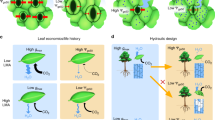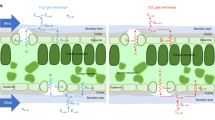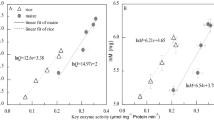Abstract
PROF. HEATH'S interpretation of my results is based on a hypothesis which, according to my experiments, is no longer valid. He assumes that water transport in the plant is mediated by a cell-to-cell mechanism and that it is the suction potential of the mesophyll cells which determines the rate of water movement through the plant. I imagine water transport from the root to the atmosphere in easily movable columns in the xylem and cell walls. The rate of transport then depends on the gradient of suction potential from the root medium to atmosphere and the permeability or resistance to water movement of the intervening stages. The cells of the plant obtain their water from the cell wall reservoir. The uptake of water does not depend on the suction potential of the mesophyll cells but on that of the air in the intercellular spaces, which is a function of that in the ambient air and the stomatal resistance. However, as the water content of both the mesophyll cells and the guard cells, at equilibrium, is determined by the cell-wall water potential (referred to earlier1 as the cell-wall water deficit), the impression is obtained that the guard cells are regulated by the mesophyll cells. When equilibrium does not occur, as can happen when a stress is suddenly released, the water content of the guard cells and the mesophyll cells may vary independently, if they have different permeabilities. The results which have been obtained experimentally agree with the supposition that the guard cells are more permeable than the mesophyll cells.
This is a preview of subscription content, access via your institution
Access options
Subscribe to this journal
Receive 51 print issues and online access
$199.00 per year
only $3.90 per issue
Buy this article
- Purchase on Springer Link
- Instant access to full article PDF
Prices may be subject to local taxes which are calculated during checkout
Similar content being viewed by others
References
Rufelt, H., Nature, 197, 985 (1963).
Allerup, S., and Nielsen, J., Physiol. Plant., 15, 172 (1962).
Rufelt, H., Physiol. Plant., 9, 154 (1956).
Jarvis, P., and Jarvis, M., Physiol. Plant., 16, 269 (1963).
Author information
Authors and Affiliations
Rights and permissions
About this article
Cite this article
RUFELT, H. Rapid Changes in Transpiration in Plants. Nature 200, 191–192 (1963). https://doi.org/10.1038/200191a0
Issue Date:
DOI: https://doi.org/10.1038/200191a0
This article is cited by
-
Rapid Changes in Transpiration in Plants
Nature (1963)
Comments
By submitting a comment you agree to abide by our Terms and Community Guidelines. If you find something abusive or that does not comply with our terms or guidelines please flag it as inappropriate.



